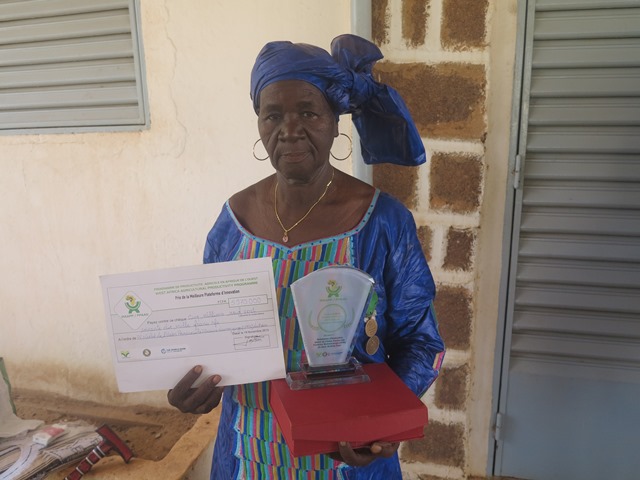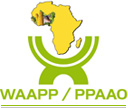
Awa Ouedraogo is about sixty years old, but she is rather a vigorous woman. She is the Chairwoman of the group of women known as Union provinciale féminine namagbzanga (UPFN) of the province of Bam, a town located 120 km north of Ouagadougou, the capital of Burkina. UPFN which includes two thousand members is the organization managing the cowpea Innovation Platform.
Currently, this innovation platform has become a reference in the West African sub-region. In just three years of existence, it has enabled the women producing cowpea to increase their income fivefold, to have the support of their community in terms of access to land but also to financial institutions.
Yet, life was not so easy for those women before the establishment of the innovation platform for women producing cowpea in Bam. They were facing the following four major challenges: lack of awareness on quality seeds; limited access to arable land; poor access to financing sources; and the lack of a functional marketing chain. Mrs. OUEDRAOGO still remembers this hard situation and declared: “These challenges have discouraged many women who abandoned their fields to go to mining sites in search of gold”.
The establishment of the Innovation Platform in July 2013 with the support of the West Africa Agricultural Productivity Programme (WAAPP) in Burkina was for those women who were about to lose hope, a true breath of fresh air.
Cowpea varieties that produce 800kg/hectare against 550 kg/hectare for the old varieties
To improve crop productivity, research centers introduced five new high-yield cowpea varieties in the innovation platform. Through guided tours, the female producers adopted and disseminated these varieties which produce an average of 800 kg/hectare against 550 kg/hectare for the old varieties. “These varieties are popular because of their high yield, short cycle and their coarse and white grains” recognized Bakary SEREME, the Provincial Director for Agriculture.
Encouraged by the success of these women, traditional leaders are conducting advocacy to facilitate women’s access to arable land and to large surface areas. In the past, arable land granted to each woman was about half a hectare. With this commitment, each woman is granted even three hectares in some villages.
Therefore, the increase of arable land granted to women encouraged financial institutions to support them. “Our participation in the guided tours on cowpea production plots contributed to convince us of the quality of the work and potential yields. As a result, we decided to increase our loans to women for cowpea production”, recognizes Aminata CISSE, a manager of a microfinance institution which is a member of the platform just like researchers and traditional leaders.
465 tons of cowpea sold in 2014 against 280 tons before the establishment of the innovation platform
In 2014, the support was used to grant a credit of 165 million CFA francs (330,000 US dollars) to 800 members of the innovation platform against 75 million CFA francs (150,000 dollars) before the establishment of the innovation platform, which represents an increase of over 100%.
This involvement of the microfinance institutions in the operation and running of the innovation platform, coupled with women’s access to quality seeds and agricultural land, increased the income of producers as follows: 465 tons of cowpea sold in 2014 for an amount of 120 million CFA francs (240,000 dollars) against average annual sales of 280 tons for a total of 72 million CFA francs (144,000 dollars) before the implementation of the innovation platform.
Those increased volumes of production have been sold through the improvement of the marketing system with a firm purchasing commitment of the National Company for the Management of Food Security Stock (SONAGESS).
“In 2014, I generated a net profit of 665,000 CFA [(1,350 dollars] by selling 5,400 kg of cowpea to SONAGESS” said GANSORE Binta, a woman aged 52 and producing cowpea in the Province of Bam; she is married with six children. This is a significant amount given that in 2014, the National Institute of Statistics and Demography (INSD) of Burkina estimated the absolute threshold of poverty at 154,000 CFA francs (310 dollars) per adult and per year in Ouagadougou, the capital. The income generated by Mrs. GANSORE is especially significant because INSD also reveals that in Burkina in 2014, nine out of ten poor people were located in rural areas.
Therefore, it is not a coincidence that the cowpea innovation platform obtained in November 2015 in Dakar, the best West African innovation platform award. The West and Central African Council for Agricultural Research and Development (CORAF/WECARD, an institution coordinating WAAPP at regional level), in collaboration with the World Bank, granted this award with an amount of six million CFA francs (12,000 dollars). The innovation platform has decided to use this money to build a cowpea storage warehouse whose first foundation stone was laid on April 22, 2016 in Kongoussi (capital of the Province of Bam).







